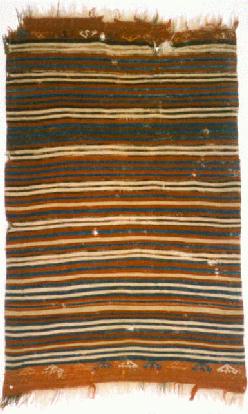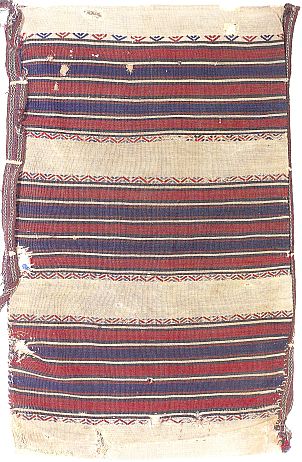One day, a few years ago, I bought, utterly on impulse, an item of flatweave with simple horizontal stripes and very good colors. Neither the dealer or I knew what it was.

(This darkish photo does not do this piece justice.)
I put it up on Turkotek as part of a discussion of backs of bags. I conjectured what it was and talked about the books I was consulting.
Jerry Silverman spoke up and said that I was likely looking at the wrong book. Jerry cited a book on Bergama grain bags and said that these "grain bags" were "killer" items and under-collected.
The book Jerry pointed to was "Bergama Cuvallari," by Doris Pinkwart and Elizabeth Steiner, 1991. This book is mostly in German, but with lots of full color photos and the detailed captions are in both German and English. Josephine Powell wrote a loose-leaf, inserted introduction. The bags were as Jerry said, but I didn't see any examples offered.
Here is the original thread from 1999 should it interest you:
http://www.turkotek.com/salon_00026/s26t3.htm
In it Marla Mallett suggested where my piece had been woven.
When my copy of Pinkwart and Steiner arrived, it further confirmed that I likely had the back of one of these grain sacks. (There is a sense in which, the "angle" of my entry into ownership of part of one of these grain bags, has affected my appreciation of them. I continue often to like the backs as much as the fronts, sometimes more.)
As the book's title indicates, these grain bags were made in a broad area of northwest Anatolia surrounding Bergama. (There were also some similar bags made in eastern Turkey about which more below.) So Bergama is a very likely place to find such bags in Turkey. And I did, but let me tell that story from its beginning.
The day after I had bought three items from the Ottoman dealer, I was standing on the sidewalk opposite the brick ruin about which my wife still wanted to check a few details. It was Sunday and we were told that most shops were shut. But as I stood I was approached by the owner of a rug shop next to the first one I had gone into the day before. He said that he knew that I was a collector and asked if he could show me some pieces. I demurred, at which point he said that he had a "unique" item, something used with babies. OK, I said, for a unique item I would drink his tea.
Inside he did have a format I can't recall seeing before. It was about 24 inches square and composed of three strips sewn together. It was plausibly a kind of blanket for a baby, but it was full of garish synthetic dyes. I mentioned this and he immediately said "I have more!" and brought out four more (so much for the claimed "uniqueness"). One of these looked legitimately older, but was composed of three strips of plain red cloth and without any decoration.
He had a nice grain bag hanging on the wall and I asked whether he had more. He did. Ultimately, he put, perhaps, 30 of them in front of me. Many had clearly synthetic dyes, but there were more than a few that seemed OK. After considering, I picked one out (it turned out the be the pair of the one on the wall). Here is the one I bought.
Front:

Turned sideways to give you a little closer look:

Back:

Again, the back turned sideways to get it closer.

In the exhibition of material from the Josephine Powell collection at ICOC XI there were similar bags.
Here is one from Powell's collection the design of which seems fairly close to that of mine.

And here is the back of the Powell piece.

Plates 29f and a close-up 30f in the Pinkwart and Steiner volume also seem similar.
The Powell piece is noticeably finer than mine, a better piece of weaving. The narrower of the two bands on the front of hers is better composed and drawn. I think mine, with its nice green, may have the edge on range of color.
The Powell piece is one of several in her collection attributed to Kilaz. I suspect that's where mine was woven, too.
One last thing: similar bags were made in Eastern Turkey and there was one in the Powell material that I find striking.

The designers of the exhibition of the Powell bags apparently did not like it as much as I do (its back is not remarkable) since they did not give it its own exhibition panel, but instead relegated it to a group exemplifying how such bags looked when full.

Nevertheless, I like it a lot.
As usual thoughts and comments are invited.
Regards,
R. John Howe
